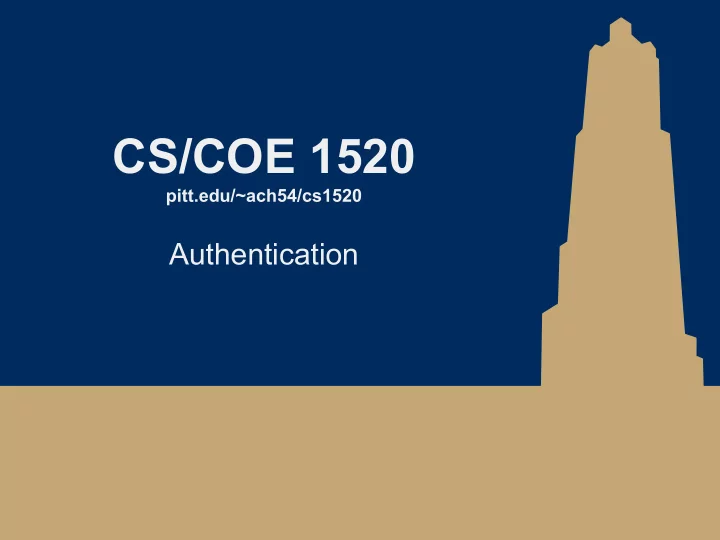

CS/COE 1520 pitt.edu/~ach54/cs1520 Authentication
Access control vs. authentication ● We want to control how users can interact with information ○ E.g., ■ Users should only be able to view their own messages ■ Users can only update their own passwords ○ This is access control ■ What actions is a subject allowed to take on a given object? ● How do we determine the who a user is? ○ This is authentication ■ The binding of an identity to a subject 2
General approaches to authentication ● Verify identity based on: ○ Something the user knows ■ E.g., password, PIN ○ Something the user has ■ E.g., ATM card, smart card ○ Something the user is ■ E.g., fingerprints, retinal scans ● Using multiple of these together leads to two-factor authentication ● Password authentication is (currently) the most widely-used authentication approach 3
Using passwords in web applications ● Up until this point, we have used HTML forms to gather and submit usernames/passwords to the server, and then set a cookie (returned with all requests) to flag the user as "logged in" ○ Where is this approach going to fall short? ● Let's look at other approaches to web app authentication 4
HTTP basic authentication ● Send username and password along with the HTTP header ○ Via the Authorization field of the header: GET / HTTP/1.1 Host: cs.pitt.edu Authorization: Basic Laha9aDS8n3q8bv … Type of Header field name Data authentication ○ Username and password are concatenated together with a single ":" and then Base64 encoded 5
Base64 encoding ● Representing data as a sequence of base 64 numbers ○ 0-25 : A-Z ○ 26-51 : a-z ○ 52-61 : 0-9 ○ 62 : + ○ 63 : / ● To convert 8-bit encoded string to Base64, grab 3 bytes of input, turn it into 4 output characters ○ If only 1 or 2 bytes left, pad out Base64 output with = 6
Grabbing basic HTTP auth in Flask ● Flask-HTTPAuth ○ An extension that allows us to easily use HTTP Auth within Flask routes ○ Initialized with auth = HTTPBasicAuth() ○ Decorators ■ @auth.login_required ■ @auth.verify_password 7
Token authentication ● Have user acquire token and then send that along with requests. ○ E.g., you can access GitHub's API by sending a token along with your request header: ○ Why is this helpful? 8
OAuth ● Allows a user to authorize a web app to access their data on another service 9
OpenID ● An approach to federated authentication ● Allows the user to gather proof that they are the owner of some identity on another site ○ Does not delegate access to the user's data on that other site, however. ● Can be used to authenticate a user to get an OAuth token 10
OAuth Example Authorization Resource 11
Token Authorization ● Can use the Bearer type of Authorization in the HTTP header: ○ Authorization: Bearer TOKENGOESHERE 12
Recommend
More recommend